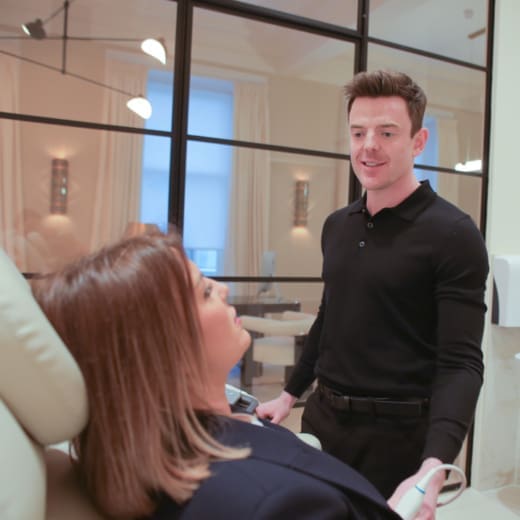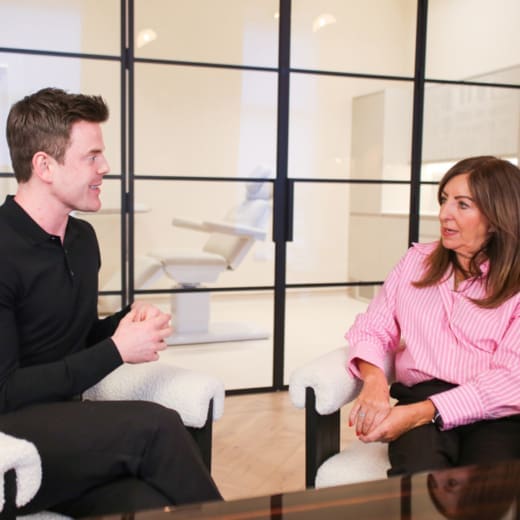McKeown Medical
167 Bath Street, Glasgow, G2 4SQ
Date posted — 13.08.24
Sun damage is, as the name suggests, changes to the skin due to long term exposure to the sun’s UV radiation.
And as the word ‘damage’ suggests, these are not positive changes.
These are changes to the structure and function of the skin that are initially visible in the way the skin looks and can eventually become severe enough that cancer cells start to develop.
So sun damage is a real problem, and something we should all take seriously.
If you think about the skin on a baby or a toddler and what it looks like, it’s usually quite pale, even in colour and smooth in texture.
Of course, this starts to change through the teenage years and the onset of puberty when the skin can become thicker with more sebaceous glands making the skin more oily.
But in general the skin remains relatively light in colour and smooth in texture.
The skin on the face doesn’t tend to stay that youthful dewy way for long.
By the time most people are in their 30s and 40s you can see visible changes have happened to the skin that continue to get worse into the 50s and 60s and beyond.
Almost all the changes we see to our skin as we age are the result of exposure to our environment and by far and away the biggest exposure is to the sun.
The next biggest environmental exposure is nicotine, although thankfully that is something we are seeing less and less of now.
To a much lesser extent, the changes to the skin we see are the result of environmental pollution and sugar (yes, too much sugar makes the skin look older too).
The first change that we see from sun damage is usually to the pigmentation of the skin.
The production of pigment – melanin – is the skin’s natural defence to protect our DNA from the harmful effects of the sun’s UV radiation.
This is the pigment we see when our skin looks tanned.
When we are young, most of us think a tan looks nice, which is why so many of us tan and don’t think about future consequences.
But years of over-production of melanin in our skin makes the mechanism by which we produce it become less well regulated, and so we develop patches of irregular pigmentation – often referred to as age spots, or hyperpigmentation.
The next change that you can see from chronic sun damage is to the vascular system on the face.
When the skin is exposed to the sun, blood is diverted to the skin to help defend it and restore normal function.
In the short term we see this as redness, often referred to as sunburn.
Due to chronic exposure, we eventually develop disregulated blood vessels on the face which cause patches of redness and visible dilated blood vessels, even when the acute effects of the sun have worn off.
This causes redness and thread veins.
The chronic inflammation caused by sun exposure also causes disruption to the collagen and elastin fibres in the deeper layer of the skin – the dermis – which is responsible for giving the skin its physical structure.
Healthy skin has well-organised patterns of collagen and elastin but with chronic sun exposure this becomes more hectic and chaotic.
The disruption of these structural molecules leads to changes to the texture of the skin – roughness, fine lines (rhytids) when the face moves and eventually even when the skin is at rest (static rhytids).
Over time, the elastin fibres can become so disorganised that they form visible little bumps on the skin referred to as ‘elastosis’ or ‘solar elastosis’ to indicate that it is caused by sun exposure.
Eventually the disregulation to the structure and function of the skin leads also to the formation of growths on the skin.
Sometimes these growths can be harmless, but sometimes the growths can become cancerous.
The effects of sun damage on the skin are cumulative – which means that they get worse over time.
I often hear patients tell me that they can’t have sun damage because they wear SPF every day and yet when I look at their skin they have plenty of signs of sun damage.
That’s because they may well take care of their skin now, but they didn’t when they were younger and it’s catching up with them now!

When it comes to your health, few things are more important than taking care of your gynaecological wellbeing. Yet many...

Varicose veins are more common in women than men. While many people associate these bulging, twisted veins with ageing or...

When you're trying to conceive, it's natural to focus on your ovulation cycles, hormone levels, and lifestyle habits. However, one...
1 / 3
2 / 3
3 / 3

When it comes to your health, few things are more important than taking care of your gynaecological wellbeing. Yet many...

Varicose veins are more common in women than men. While many people associate these bulging, twisted veins with ageing or...

When you're trying to conceive, it's natural to focus on your ovulation cycles, hormone levels, and lifestyle habits. However, one...
Another year, another round of incredible transformations from our team at McKeown Medical!
Eye bags banished, jowls lifted, skin refined, veins gone. Thank you so much to all of our patients who have allowed us to share their photos with you and thank you to our incredible team who work so hard to take care of every patient who trusts us with their care.
Here’s to 2026 and another year of incredible transformations!

“But Daddies, WHEN is Santa coming? I want to wait up for him!”
Happy Christmas to all, and to all a good night 🎅🏻

Laser rejuvenation of the eye area can be an incredibly powerful tool for the right patients, especially those whose ‘bags’ are more about loose skin and fine lines, like this lovely patient here.
We treated her with full field ablation, which takes around 2 weeks to recover from. Her she is a few weeks later and you can see how much tighter the skin is, the crepey skin has gone and the fine lines have been ironed out. The patient is over the moon.
What do you think?

Eyelid surgery is one of the most popular procedures we do in the clinic. It’s a great fix for hooded eyes! Excess skin on the upper eyelids can not only create a hooded, heavy appearance but often affects the vision too.
Here’s the very talented @bramhallplasticsurgery discussing how upper eyelid surgery (blepharoplasty) can restore a more open, refreshed look by removing the excess skin and subtly redefining the natural eyelid crease. Scars are hidden within the fold of the eyelid, leaving eyes that look brighter, not “done.”
Do you have any questions about surgery? Ask in the comments or send us a message!

Thank you to our patient for allowing us to share her before and after photos of her upper blepharoplasty.
Excess skin on the upper eyelids can make the eyes appear tired or heavy. This simple procedure restores a lighter, more open look while keeping the result completely natural.
Another fabulous result from the very talented @bramhallplasticsurgery!
What do you think?

We’ve been in our new home for a year now and I thought this would be a good time to remind you just how special it is with a little video tour.
It’s been a remarkable year for us in our new home; we’ve introduced new doctors, new treatments, new services and our team continues to grow from strength to strength - always striving to provide more and better for our wonderful patients.
Enjoy the tour!

About last night… It was time once again for our annual Christmas celebration with this absolute bunch of legends. We were a little earlier than usual this year so we could have has many people available as possible, and the evening did not disappoint.
A few sore heads this morning, but absolutely worth it to celebrate the hard work this team dedicate to our patients day in, day out all year round. I am very proud to have the undisputed best team on the planet. Merry Christmas everyone! 🎄

Fine lines etched into the skin around the mouth - this is a common problem and in this patient`s case she had what we call ‘actinic elastosis’, whereby abnormal bands of elastin build up in the skin as a result of years of previous sun exposure.
When patients have this condition, the gold standard way of dealing with it is fully ablative laser resurfacing. It’s an intense treatment with two weeks of downtime afterwards, but the results are spectacular - just like in this lovely patient.
The after photo is three weeks after the treatment and you can see that the skin is still a little pink, which will continue to fade over the next few months.
The patient is already delighted with the result - what do you think?

It’s beginning to look a lot like Christmas!
At least according to Michael Buble, who’s been on repeat in the clinic this week. The decorations are up and we are officially in ‘our season’. The clinic has been packed with everyone having their skin polished in time to make it on the nice list. If you’ve still to make a pre-Christmas appointment, we’ve still got some spaces left for your festive glow up.
Ho ho ho everyone… It’s time for Santa!!!! 🎅🏻
